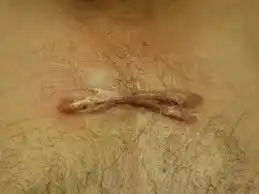Keloids are overgrown scars that develop due to an abnormal healing response after skin injury. They extend beyond the original wound and can become large, raised, and uncomfortable. Commonly occurring after piercings, surgeries, or trauma, keloids can be particularly troublesome on the ears and sternum. Advanced treatment options such as Fillet Flap Surgery, Laser Excision (CO2 Laser) for ear keloids, and Intralesional Injections, Cryotherapy, and Surgical Excision for sternum keloids offer effective solutions to reduce and manage these scars.
Conditions Treated:
Ear Keloids: Keloids on the ears, often caused by piercings, can be unsightly and may continue to grow over time. Treatment for ear keloids includes:
- Fillet Flap Surgery: A technique where the keloid is surgically excised, and the surrounding skin is used to cover the area, minimizing the chances of recurrence.
- Laser Excision (CO2 Laser): A precise method where the keloid is removed using laser technology, offering a less invasive approach with reduced scarring and faster recovery.
Sternum Keloids: Keloids on the sternum (chest) are common due to surgical scars or acne. They can be painful, itchy, and sensitive. Treatment options include:
- Intralesional Injections: Steroids are injected directly into the keloid to reduce its size, soften the scar tissue, and prevent further growth.
- Cryotherapy: Involves freezing the keloid with liquid nitrogen, which reduces the size and improves the appearance of the scar.
- Surgical Excision: The keloid is surgically removed, often combined with other therapies (like injections or cryotherapy) to reduce the chances of regrowth.
Symptoms That May Lead to Keloid Treatment:
- Raised, Enlarged Scars:
- Keloids are typically firm, raised, and larger than the original wound.
- They may continue to grow even after the wound has healed.
- Discoloration:
- Keloids often appear darker than the surrounding skin, either pink, red, or purple, especially in darker skin tones.
- Itching and Discomfort:
- Keloids can cause persistent itching, tenderness, and discomfort, particularly when stretched or rubbed against clothing or jewelry.
- Functional Impairment:
- Keloids in areas like the ear can affect ear shape or obstruct wearing earrings. On the sternum, they can be painful and sensitive to touch.
- Emotional Distress:
- Due to their appearance, keloids can lead to self-consciousness or anxiety about one’s physical appearance, particularly in visible areas like the ears or chest.
What to Do Before Keloid Treatment:
- Consultation with a Specialist: It is important to consult with a dermatologist or plastic surgeon specializing in keloid treatment. They will evaluate the size, location, and severity of the keloid to recommend the best course of action.
- Treatment Plan Customization: Depending on the location and size of the keloid (ear or sternum), the specialist will suggest the appropriate treatment, such as surgery, injections, or laser therapy.
- Pre-Treatment Skin Care: Keeping the affected area clean and avoiding any trauma to the keloid before treatment is essential. Your doctor may recommend moisturizing the area to reduce inflammation before the procedure.
Post-Treatment Care for Keloid Treatment:
- Wound Care: After treatment, follow proper wound care protocols, such as keeping the area clean and using prescribed ointments to prevent infection and promote healing.
- Avoid Sun Exposure: Protect the treated area from the sun as UV rays can darken scars and delay healing. Use sunscreen or cover the area with clothing.
- Pressure Therapy: For ear keloids, pressure earrings may be prescribed after surgery to prevent the recurrence of keloids. Compression helps flatten the scar tissue.
- Follow-Up Treatments: Depending on the treatment (especially for injections or cryotherapy), multiple sessions may be required for optimal results. Regular follow-ups with your doctor ensure that the keloid does not regrow and that the area heals properly.
- Minimize Trauma: Avoid any further trauma to the treated area, such as wearing tight clothing on the chest or earrings in recently treated ear keloids, as this can trigger keloid regrowth.
Conclusion:
Treating keloids, whether on the ear or sternum, requires a tailored approach based on the location, size, and individual skin type. For ear keloids, advanced techniques like Fillet Flap Surgery and Laser Excision (CO2 Laser) offer effective, minimally invasive solutions, while sternum keloids benefit from Intralesional Injections, Cryotherapy, and Surgical Excision. Combining treatments with proper post-care can significantly reduce the recurrence of keloids, improve cosmetic outcomes, and enhance the patient’s comfort. Consultation with an experienced dermatologist or surgeon is crucial to achieving the best results.



